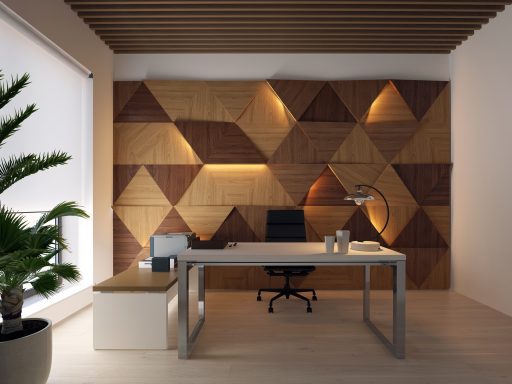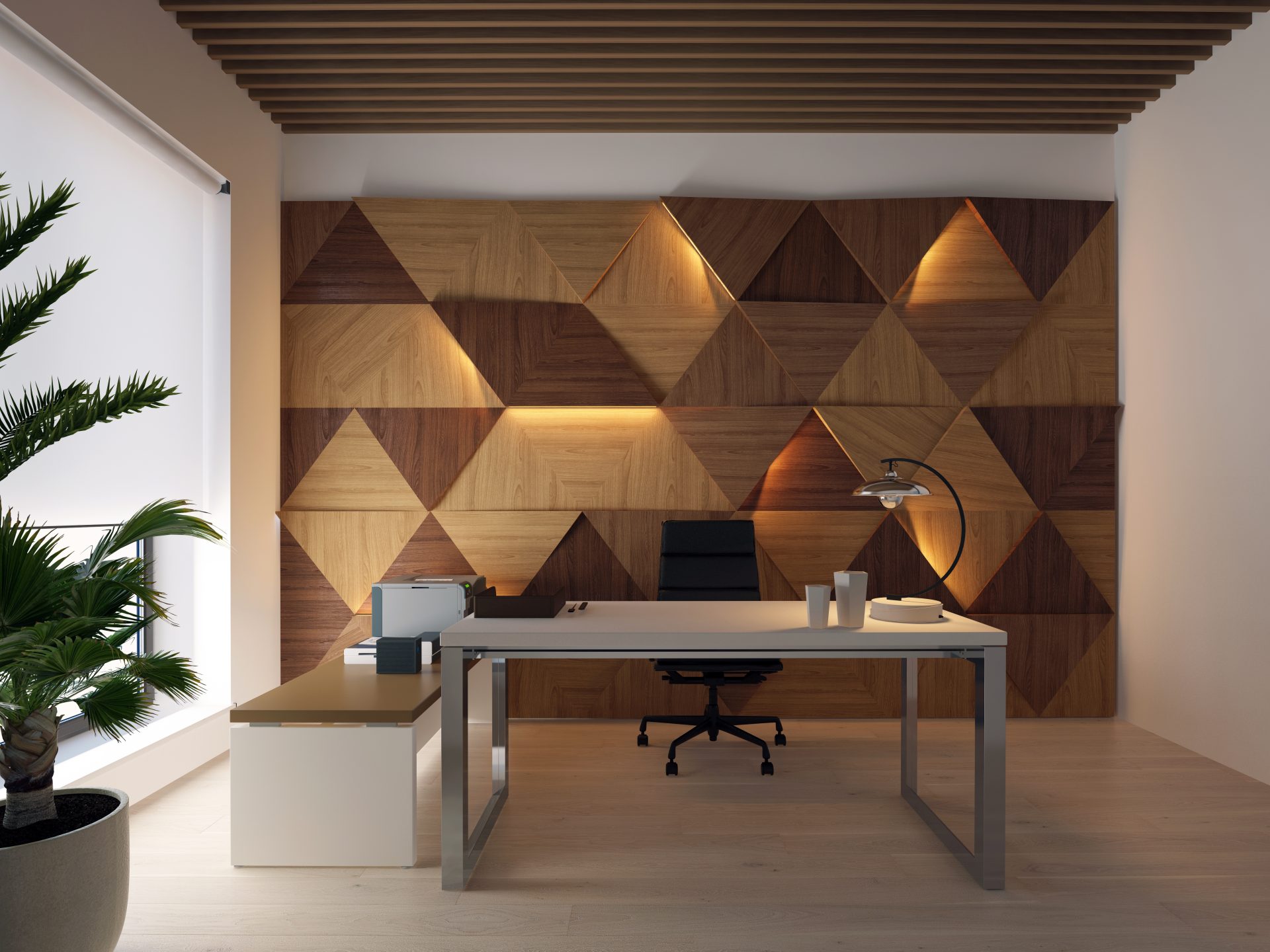In the dynamic field of office interior design, wall panels are increasingly emphasised for their dual benefits of aesthetic enhancement and practical utility. These elements are pivotal in transforming dull office spaces into vibrant hubs of creativity and collaboration. With a plethora of designs on offer, modern wall panels not only elevate visual interest but also provide functional benefits like improved acoustics and defined space boundaries.
As office layouts become more flexible and adaptable, the significance of wall panels grows. The introduction of novel materials and textures, along with the strategic incorporation of natural light, has driven the evolution of wall panel designs. This advancement reflects the contemporary tenets of office aesthetics and boosts occupant well-being, promoting a sense of community and inclusivity.
Current trends in wall panels align well with a company’s branding and ethos, considering regional design nuances. From three-dimensional textures that invigorate a space to smart adaptations for various working styles, wall panels are integral to creating an enhanced workplace experience for clients and staff alike.
Major Insights:
- Wall panels significantly uplift the aesthetic and functional aspects of office interiors.
- Modern designs accommodate the evolving dynamics of workplaces and health considerations.
- They offer versatile solutions that resonate with brand identities and regional preferences.
Evolving Trends in Office Design:
Designers are now focusing on sustainability, adaptability to hybrid work models, and increased technological integration as office environments evolve.
Eco-Friendly Materials in Wall Designs:
Today’s office design trends are dominated by sustainability, with eco-conscious material choices like bamboo, reclaimed wood, and recycled plastics used in wall panels, thereby reducing environmental impact while adding visual warmth and texture.
Hybrid Office Layouts:
The future of workplace environments is shaped by hybrid offices, blending traditional setups with remote working flexibility. Wall designs now include movable panels and modular systems that effortlessly adapt to various needs, facilitating the configuration of both collaborative and private spaces.
Technological Enhancements:
Wall panel designs are embracing technological advancements that change workplace interactions. Features such as integrated touchscreens for managing spaces, soundproofing technologies, and built-in charging stations are revolutionising office dynamics, fostering a more efficient and productive environment.
Innovations in Materials and Textures:
Office interiors are experiencing a transformation in the use of materials and textures to enhance both aesthetics and functionality. Designers are utilising wood, MDF, natural elements, and concrete to craft visually appealing spaces with rich textural depth.
Wood and MDF Variants:
Wood and MDF (Medium-density fibreboard) remain popular in wall panel choices for their natural allure and adaptability. Wood panels come in various finishes, from light ash to rich walnut, each adding a unique ambiance to office spaces. MDF is chosen for its smooth finish, suitable for veneers and laminates that provide vibrant colours and intricate designs, supporting sustainability from responsibly managed forests.
Available Finishes:
- Ash
- Oak
- Walnut
- Painted MDF
- Veneer
Natural and Raw Materials:
Incorporating natural materials in wall designs fosters biophilic connections, enhancing employee well-being. Materials like exposed brick, stone, and bamboo not only introduce texture but also an unrefined charm to the design theme, often featuring an exposed brick wall for rustic allure or bamboo panels for a calm, natural ambiance.
Natural Textures:
- Stone
- Bamboo
- Cork
- Brick
Concrete and Geometric Designs:
Concrete is favoured for its minimalistic appeal and durability, especially in modern office spaces. Its subtle tones and textured finishes offer an industrial look that aligns with contemporary design aesthetics. Similarly, wall panels with geometric patterns introduce a dynamic and stylish element to interiors, often acting as eye-catching focal points that inspire creativity.
Concrete Variations:
- Smooth
- Textured
- Patterned
Geometric Motifs:
- Hexagonal
- Chevron
- 3D Effects
The Role of Natural Light:
Maximising natural light in office interiors is essential for enhancing employee well-being and optimising workspace functionality. Innovative design strategies that amplify daylight are not merely trends but deliberate approaches to improve productivity and elevate the overall office atmosphere.
Promoting Wellbeing with Natural Light:
Natural light is vital in the workplace for boosting mood, reducing fatigue, and enhancing comfort. Offices designed with ample natural light support employees’ circadian rhythms, contributing to better sleep and increased alertness. Research indicates that natural light can significantly improve cognitive function, making it a critical element in office designs focused on well-being.
Strategies to Maximise Daylight:
- Optimal Workstation Placement: Arranging desks to maximise daylight exposure.
- Glass Partitions: Employing glass walls to let light permeate the office.
- Reflective Surfaces: Using materials that reflect light to further brighten spaces.
- Strategic Colour Choices: Selecting wall colours that enhance light without overwhelming the senses.
These design choices position natural light as a transformative element in contemporary office interiors, fulfilling both functional and aesthetic roles.
Encouraging Collaboration and Community:
The design of office interiors significantly affects how individuals collaborate and connect within the workplace. Cutting-edge wall panel designs are crucial in creating environments that encourage teamwork and community among employees.
Integrated Meeting Rooms:
Meeting rooms with integrated wall panels support a variety of collaborative activities. These panels often feature writable surfaces or screens for presentations, while glass partitions maintain an open feel yet provide sound privacy for confidential discussions.
Features of Integrated Meeting Room Panels:
- Soundproofing for private meetings.
- Translucent or clear materials to enhance spatial perception.
- Modular designs for adjustable room sizes.
Coworking Space Designs:
Coworking spaces benefit from lively and adaptable wall panels that mirror the creative and entrepreneurial spirit of their users. These panels typically feature modular systems that can be reconfigured to meet evolving needs.
Design Traits for Coworking Spaces:
- Interactive surfaces for sharing ideas and projects.
- Integrated shelving for communal resource access.
- Diverse colours and textures to define different areas within the space.
Social and Recreational Areas:
Social and recreational zones in offices are essential for fostering community. Wall designs in these areas might feature themed panels, such as those with sports motifs or pub-like decor, creating unique settings that encourage casual interactions and relaxation.
Design Elements for Social Zones:
- Durable materials for high-traffic areas.
- Visual signals like images or colours indicating the area’s function.
- Layouts that support social activities, from coffee corners to gaming areas.
Adapting Design for Flexibility:
In today’s office interiors, flexibility is key to accommodating diverse work styles and purposes. Design features that offer modularity and multipurpose functionality are essential for creating spaces that adapt to flexible schedules and hybrid work models.
Flexible Wall Panel Systems:
Flexible wall panel systems are fundamental to modern office design. These systems allow spaces to be quickly reconfigured for various uses, from collaborative projects to private work, featuring:
- Modularity: Panels can be moved, added, or removed to meet changing needs without major renovations.
- Technology Integration: Smart technology options enhance panel functionality, integrating seamlessly with the office’s digital infrastructure.
Versatile Furniture Options:
Furniture also plays a crucial role in the flexibility of an office. Highlights include:
- Convertible Designs: Multi-functional furniture like adjustable desks accommodate various work preferences, supporting both sitting and standing positions.
- Easy Storability: Lightweight, stackable, or foldable furniture pieces facilitate quick spatial reconfigurations, suitable for dynamic work environments.
These design approaches ensure that offices remain agile and responsive to changing work patterns while promoting productivity and collaboration.
Wall Panels as Decorative Features:
In contemporary office settings, wall panels not only fulfil functional roles but also serve as potent decorative elements that accentuate brand personality and enrich the workspace with visual and conceptual depth.
Highlighting Brand Identity:
Office interiors often use wall panels to articulate a company’s identity. By choosing the appropriate textures, colours, and patterns, these panels become more than just structural elements; they evolve into narratives that embody a brand’s ethos and aesthetic vision.
Innovating Beyond Space with Samsen:
Samsen furniture is celebrated for its ‘Beyond Space’ concept, which goes beyond traditional design limits to expand spatial perceptions. Wall panels are central to this philosophy, turning functional areas into visual spectacles that enhance and redefine the concept of space through innovative design and strategic positioning.
Inspiration from Note Design Studio:
The Swedish collective Note Design Studio offers ample inspiration for wall panel designs that blend functional utility with decorative elegance. Their approach, characterised by clean lines and subdued yet warm colour palettes, transforms spaces into modernist environments where each panel contributes to a setting that is as motivational as it is practical.
Design Considerations for Different Regions:
Local design factors are essential for creating relevant and effective office interiors. Considerations such as climate, cultural norms, and regional trends influence the selection and application of wall panel designs in various international business centres.
Meeting the Demands of New York and New Jersey Offices:
In New York and New Jersey, office interiors reflect the dynamic and sophisticated nature of these East Coast centres. Wall panelling in these regions often features high-quality materials and sleek finishes to mirror the avant-garde, cosmopolitan atmosphere. Acoustic wall panels are particularly valuable for mitigating the ambient noise typical of such lively areas.
Californian Office Design Preferences:
California workspaces emphasize style and sustainable functionality. Offices in this state prefer using sustainable materials like reclaimed wood or low VOC-emitting materials. Natural light is pivotal, with designs often incorporating translucent or frosted glass panels that maximise sunlight while maintaining privacy.
High-Tech Innovations in Singapore Office Designs:
Singapore office designs blend a global outlook with a preference for high-tech solutions and functionality. Wall panels may include features like built-in interactive displays and are made from materials suitable for the tropical climate, which includes dealing with high humidity levels that could otherwise damage certain materials.
Enhancing the Client and Employee Experience:
Revitalising office interiors with trending wall panel designs significantly influences both client and employee experiences. These innovative elements meet various business needs while ensuring comfort and functionality, crucial in the workplace reshaped by the pandemic.
Creating Tailored Environments for Business Requirements:
Today’s businesses need office interiors that are more than just workplaces; they should reflect the brand’s identity and values. Three-dimensional wall panels, for example, provide both visual allure and acoustic benefits, fostering an environment that supports focused work and client interactions. Designs are chosen to resonate with a brand’s image, incorporating features that speak to innovation and creativity.
Focusing on Comfort and Functionality:
With an increased emphasis on remote working, office designs now prioritise employee wellbeing. Wall panel choices not only impact visual aesthetics but also enhance the overall comfort of the workspace. This includes:
- Ergonomic Panel Designs: These improve acoustic comfort, minimising distractions.
- Biophilic Wall Designs: Incorporating natural elements to promote mental health and wellbeing.
As employees spend significant time indoors, it’s crucial to create spaces that are both inviting and beneficial to their mental health. Office interiors must balance practical needs with an environment that supports and boosts the well-being of all users.
Implementing Cutting-Edge Solutions:
The inclusion of state-of-the-art wall panel designs is critical when refreshing office interiors. Through interactive features and considerations for post-pandemic realities, these solutions enhance both functionality and aesthetic appeal in modern workplaces.
Interactive Wall Panels and Features:
More and more office interiors are adopting interactive wall panels with integrated smart technology. These panels function not just as decorative elements but as practical tools for a dynamic work environment. They may include:
- Touch-sensitive Surfaces: Enable employees to interact with digital screens for presentations or collaborative tasks.
- Integrated LED Displays: Provide customizable announcement boards or mood-enhancing visuals.
Such technology-rich panels also support room wayfinding solutions and can provide critical data insights through connected workplace management systems.
Adjustments for Post-Pandemic Office Designs:
The pandemic has necessitated significant changes in office design. Wall panels now play a role in:
- Health and Safety: Panels with antibacterial surfaces or materials that are easy to clean help maintain high hygiene standards.
- Spatial Dividers: Wall panels are used to create physical barriers, aiding in social distancing while maintaining design integrity.
These adaptations highlight the ongoing need for materials that support workforce well-being, underscoring the continued importance of sustainability and cleanliness in office design during and after health crises.
Frequently Asked Questions:
This section answers common questions about the evolution of wall panelling in office interiors, focusing on the integration of style and functionality.
What are the latest trends in wall panelling for office interiors?
The newest trends in office wall panelling include three-dimensional designs that create captivating patterns and textures. Asymmetrical panels offer a modern and unique look, fostering a dynamic and creative workspace.
How can you incorporate creative wall designs in a professional office setting?
Creative wall designs in a professional environment can be achieved using asymmetrical panelling, incorporating contrasting colours, and utilising materials like MDF or slat wall panels for a contemporary yet formal office atmosphere.
Which design ideas are currently popular for professional office wall decor?
Current preferences for professional office wall decor include bold designs with contrasting colours and shapes. Popular choices feature wooden accents and glass partitions, often arranged in dynamic configurations that enhance the workspace.
Can you provide examples of innovative back wall designs for small offices?
Innovative back wall designs for small offices include geometric patterns, acoustic panels that double as visual art, and integrated shelving within the panelling for functionality and space efficiency.
What are some modern approaches to office wall design that combine functionality and style?
Modern office wall designs blend functionality with style through the use of acoustic panels, writable and magnetic walls for brainstorming, and LED-lit panels that both illuminate and decorate the space.
How can existing wall panelling be updated to look modern and on-trend?
Existing wall panelling can be updated by painting it in contemporary colours, adding trim or moulding for a three-dimensional effect, or mixing materials like metal with traditional wood to achieve a more current and trendy appearance.







